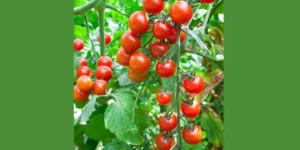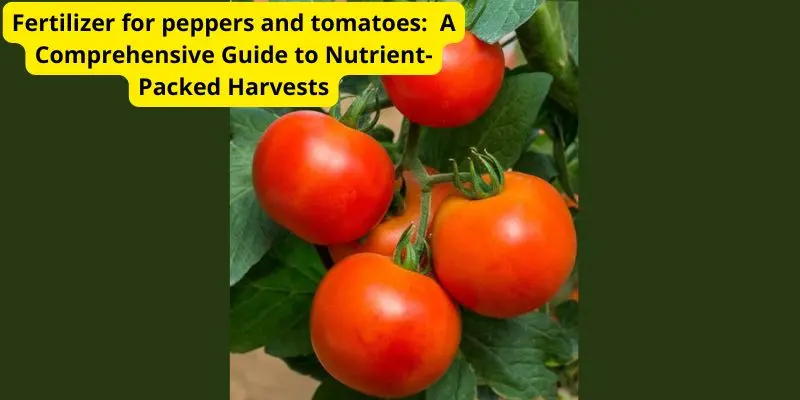Peppers and tomatoes are beloved garden staples known for their vibrant flavors and nutritional value. To achieve bountiful yields of these delicious crops, proper fertilization is essential. This guide explores the world of fertilizers, providing insights into the nutrients your plants crave, the best application methods, and troubleshooting common fertilizer-related issues.
Whether you prefer organic or inorganic options, we’ll help you find the perfect fertilization strategy to cultivate healthy and productive pepper and tomato plants.
Understanding Plant Nutrition

The Role of Macronutrients
- Nitrogen (N): Essential for leaf growth, chlorophyll production, and overall plant vigor.
- Deficiency symptoms: yellowing leaves, stunted growth.
- Excess: excessive leaf growth, delayed flowering and fruiting.
- Phosphorus (P): Crucial for root development, flower and fruit formation, and energy transfer.
- Deficiency symptoms: purple coloration on leaves, poor root growth, slow maturity.
- Excess: can interfere with the uptake of other nutrients.
- Potassium (K): Involved in water regulation, disease resistance, and overall plant health.
- Deficiency symptoms: leaf scorching, weak stems, reduced yield.
- Excess: can lead to magnesium deficiency.
Secondary Nutrients
- Calcium (Ca): Important for cell wall formation, fruit development, and preventing blossom end rot.
- Deficiency symptoms: blossom end rot, stunted growth, weak stems.
- Magnesium (Mg): Essential for chlorophyll production and enzyme activation.
- Deficiency symptoms: yellowing between leaf veins, reduced chlorophyll.
- Sulfur (S): Involved in protein synthesis and chlorophyll production.
- Deficiency symptoms: yellowing of young leaves, stunted growth.
Micronutrients
- Brief overview of micronutrients (iron, zinc, boron, copper, manganese, molybdenum, chlorine)
- Their importance in small quantities for plant health
- General deficiency symptoms (e.g., chlorosis, stunted growth, deformed leaves)
Factors Affecting Nutrient Availability
- Soil pH: how it influences nutrient solubility and uptake
- Soil texture: sandy, clay, or loamy soils and their nutrient-holding capacity
- Organic matter: its role in improving soil structure and nutrient retention
- Climate: temperature and precipitation impact nutrient availability
By understanding these essential nutrients and their roles, gardeners can make informed decisions about fertilizing their pepper and tomato plants.
Fertilizer Ratios for Peppers and Tomatoes
Understanding NPK Ratios
- Breaking down the NPK numbers (Nitrogen, Phosphorus, Potassium)
- Importance of balanced ratios for optimal plant growth
Fertilizer Needs at Different Growth Stages
- Seedling stage: High nitrogen for healthy foliage development
- Vegetative growth: Balanced NPK ratio for overall growth
- Flowering and fruiting: Increased phosphorus and potassium for bloom and fruit set
Common Fertilizer Ratios for Peppers and Tomatoes
- Popular NPK ratios for both crops (e.g., 10-10-10, 5-10-5, 8-4-8)
- Specific recommendations for organic and inorganic fertilizers
- Adjusting ratios based on soil test results
Factors Affecting Fertilizer Requirements
- Soil type and fertility
- Climate and growing conditions
- Plant variety and growth habit
By understanding the specific nutrient needs of peppers and tomatoes at different growth stages, gardeners can tailor their fertilizer applications for maximum yield and quality.
Organic Fertilizers for Peppers and Tomatoes
Benefits of Organic Fertilizers
- Improve soil structure and fertility
- Enhance soil microbial activity
- Promote healthier plant growth and taste
- Reduce environmental impact
Popular Organic Fertilizer Options
Compost: Rich in organic matter, provides a slow-release source of nutrients.
- Application: Incorporate into soil before planting or as a side dressing.
Manure: Excellent source of nitrogen, phosphorus, and potassium.
- Application: Apply composted manure to soil before planting. Avoid fresh manure.
Fish emulsion: Liquid fertilizer rich in nitrogen and other micronutrients.
- Application: Apply diluted solution as a foliar spray or soil drench.
Seaweed extract: Contains growth hormones and micronutrients.
- Application: Apply diluted solution as a foliar spray or soil drench.
Bone meal: High in phosphorus, beneficial for flower and fruit development.
- Application: Incorporate into soil before planting or as a side dressing.
Blood meal: High in nitrogen, promotes leafy growth.
- Application: Use cautiously as it can be high in nitrogen.
Application Tips
- Soil testing: Determine nutrient deficiencies before applying fertilizers.
- Combination: Use a combination of organic fertilizers for balanced nutrition.
- Timing: Apply fertilizers based on plant growth stage.
- Side dressing: Apply fertilizers around the base of plants, avoiding direct contact with stems.
- Foliar feeding: Apply diluted liquid fertilizers to leaves for quick nutrient uptake.
By utilizing organic fertilizers, gardeners can cultivate healthy, flavorful peppers and tomatoes while nurturing the soil ecosystem.
Inorganic Fertilizers for Peppers and Tomatoes
Pros and Cons of Inorganic Fertilizers
Pros:
- Highly concentrated nutrients for quick results
- Precise nutrient ratios for specific plant needs
- Easy to apply and measure
Cons:
- Can burn plants if applied incorrectly
- Potential for nutrient runoff and environmental pollution
- May not improve soil structure
Common Inorganic Fertilizer Options
- Complete fertilizers: Contain NPK ratios for overall plant growth (e.g., 10-10-10, 20-20-20)
- Nitrogen-based fertilizers: Primarily used for vegetative growth (e.g., ammonium nitrate, urea)
- Phosphorus-based fertilizers: Essential for flowering and fruit development (e.g., triple superphosphate)
- Potassium-based fertilizers: Improve disease resistance and fruit quality (e.g., potassium sulfate)
Conclusion
By understanding the intricate relationship between peppers, tomatoes, and fertilizers, you can significantly enhance your garden’s productivity and the flavor of your harvest. Remember, the key to success lies in a balanced approach that considers your soil’s condition, plant growth stages, and your preferred fertilization method.
Whether you opt for organic or inorganic fertilizers, consistent monitoring and adjustment are crucial. Experiment with different techniques and products to find the optimal fertilization regimen for your specific growing conditions. With careful attention to your plants’ nutritional needs, you’ll be rewarded with abundant yields of delicious peppers and tomatoes. Happy gardening!





